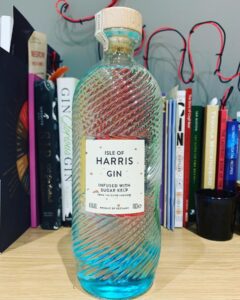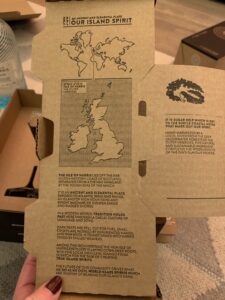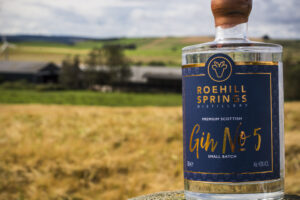 As a birthday treat, I decided I would like some fancy martini glasses. So I instantly turned to the Isle of Harris distillery. And because I was already spending money on postage and I have zero restraint, I also treated myself to a bottle of their gin. Even if you don’t know much about the gin, I’m sure you recognise the beautiful glass bottle designed to reflect the ripples of the ocean. I met the team when I went to Edinburgh for International Scottish Gin Day in 2019 and they explained the irregularities in the curves are designed to fit perfectly in your hand. The Isle of Harris is in the Outer Hebrides, and the distillery is based in the small village of Tarbert.
As a birthday treat, I decided I would like some fancy martini glasses. So I instantly turned to the Isle of Harris distillery. And because I was already spending money on postage and I have zero restraint, I also treated myself to a bottle of their gin. Even if you don’t know much about the gin, I’m sure you recognise the beautiful glass bottle designed to reflect the ripples of the ocean. I met the team when I went to Edinburgh for International Scottish Gin Day in 2019 and they explained the irregularities in the curves are designed to fit perfectly in your hand. The Isle of Harris is in the Outer Hebrides, and the distillery is based in the small village of Tarbert.  They are famous for their use of sugar kelp as their key botanical which is collected by hand from local sea lochs to ensure sustainability. The way they ensure this is by only picking the kelp if there is an ‘r’ in the name of the month – if not, then it is left to grow and recover. Alongside the sugar kelp are some more usual botanicals: juniper, cassia bark, coriander seed, angelica bark, cubeb pepper, liquorice root, orris root, and rounded off with bitter orange peel. These are distilled in a traditional copper pot before being bottled and labelled on site. They are unusual in that they don’t recycle the heads or tails of their gin – whilst a lot of distillers redistill this, the Isle of Harris team get rid of it completely. It is more expensive for them, but for them it means they are only bottling the best of their product. They also use all cardboard packaging, covered in information about the brand which makes it extra special to open. So, how does it taste?
They are famous for their use of sugar kelp as their key botanical which is collected by hand from local sea lochs to ensure sustainability. The way they ensure this is by only picking the kelp if there is an ‘r’ in the name of the month – if not, then it is left to grow and recover. Alongside the sugar kelp are some more usual botanicals: juniper, cassia bark, coriander seed, angelica bark, cubeb pepper, liquorice root, orris root, and rounded off with bitter orange peel. These are distilled in a traditional copper pot before being bottled and labelled on site. They are unusual in that they don’t recycle the heads or tails of their gin – whilst a lot of distillers redistill this, the Isle of Harris team get rid of it completely. It is more expensive for them, but for them it means they are only bottling the best of their product. They also use all cardboard packaging, covered in information about the brand which makes it extra special to open. So, how does it taste?
Month: October 2020
Shetland Reel tasting pack
Note: The tasting pack was gifted to me by Shetland Reel, but I will let you know what I really think.
 Shetland Reel gin comes from Saxa Vord Distillery, the most northern distillery in the UK on Unst, which is the mort northern inhabited island. This is a remote distillery, accessible from the Shetland mainland by not one, but two ferry journeys – not including the ferry to get to Shetland in the first place! Fun fact – it’s actually closer to Norway than it is to most of Scotland. It is here that Frank and Debbie Strang regenerated the former RAF site into a tourist resort, and teamed up with Stuart and Wilma Nickerson who own The Malt Whisky Company. Their unique surrounding inspired them to make the most of their local botanicals used in their core range. Recently they have created tasting packs of their three main gins – the Original, Simmer, and Ocean Sent. If you’ve paid attention to my social media, you’ll see I’ve also recorded these tastings with Debbie, which was an absolute blast, and you can watch them here.
Shetland Reel gin comes from Saxa Vord Distillery, the most northern distillery in the UK on Unst, which is the mort northern inhabited island. This is a remote distillery, accessible from the Shetland mainland by not one, but two ferry journeys – not including the ferry to get to Shetland in the first place! Fun fact – it’s actually closer to Norway than it is to most of Scotland. It is here that Frank and Debbie Strang regenerated the former RAF site into a tourist resort, and teamed up with Stuart and Wilma Nickerson who own The Malt Whisky Company. Their unique surrounding inspired them to make the most of their local botanicals used in their core range. Recently they have created tasting packs of their three main gins – the Original, Simmer, and Ocean Sent. If you’ve paid attention to my social media, you’ll see I’ve also recorded these tastings with Debbie, which was an absolute blast, and you can watch them here.
Shetland reel gin video tastings
Debbie from Shetland Reel gin kindly sent me one of their tasting packs to try, and we decided it would be fun to do some virtual tastings together. I’ve collated the videos below for your viewing pleasure…
You can find the Shetland Reel team on Facebook, Twitter and Instagram. You can get your hands on a tasting pack for £39.50 from their website (at time of writing).
I was introduced to Shetland Reel by The Gin Cooperative as part of my support for International Scottish Gin Day, make sure you check them out and pour yourself a Scottish gin on 24 October to celebrate! Let me know your favourite Scottish gin on Twitter and Instagram.
Meet the makers…Roehill Springs
 As we lead up to International Scottish Gin Day, I’ve teamed up with Roehill Springs gin to find out a bit more about them. They kindly sent me a bottle of their Gin No.5 to try, and I chatted to Shirley, one half of the founding team, about their background, inspirations and future plans.
As we lead up to International Scottish Gin Day, I’ve teamed up with Roehill Springs gin to find out a bit more about them. They kindly sent me a bottle of their Gin No.5 to try, and I chatted to Shirley, one half of the founding team, about their background, inspirations and future plans.
Roehill Springs Gin No.5
Note: The team at Roehill Springs kindly sent me a bottle of their gin to try, but as always I’ll let you know what I honestly think
 Roehill Springs Distillery is one of the newer distilleries emerging in the Scottish gin scene. Established in 2019, they’re based near Keith – sort of between Aberdeen and Inverness – on their third-generation farm. They are also one of the few distilleries that actually make their own gin – all of their gin is distilled, bottled and labelled on site, nothing is contracted to established distilleries (FYI – there’s nothing wrong with doing that, but lots of people don’t admit it and that’s misleading). So, why is this called Gin No.5? Where are numbers 1-4? After plucking up the courage to have a go at making his own gin, Duncan experimented with different batches and recipes and after many tasting sessions at home with friends and family, they settled on the fifth recipe, and in turn the name. Duncan, alongside wife Shirley, distil their gin in a traditional 30l copper pot still using botanicals foraged from the local area before blending it with spring water from Roehill (an area named after the abundance of Roe deer), which, as you can probably guess, also helped them name their distillery. Using a mixture of the copper pot still, a column still and a vapour basket, they add juniper, coriander, angelica root, cassia bark, pink peppercorns, and then some secret ingredients which they won’t disclose.
Roehill Springs Distillery is one of the newer distilleries emerging in the Scottish gin scene. Established in 2019, they’re based near Keith – sort of between Aberdeen and Inverness – on their third-generation farm. They are also one of the few distilleries that actually make their own gin – all of their gin is distilled, bottled and labelled on site, nothing is contracted to established distilleries (FYI – there’s nothing wrong with doing that, but lots of people don’t admit it and that’s misleading). So, why is this called Gin No.5? Where are numbers 1-4? After plucking up the courage to have a go at making his own gin, Duncan experimented with different batches and recipes and after many tasting sessions at home with friends and family, they settled on the fifth recipe, and in turn the name. Duncan, alongside wife Shirley, distil their gin in a traditional 30l copper pot still using botanicals foraged from the local area before blending it with spring water from Roehill (an area named after the abundance of Roe deer), which, as you can probably guess, also helped them name their distillery. Using a mixture of the copper pot still, a column still and a vapour basket, they add juniper, coriander, angelica root, cassia bark, pink peppercorns, and then some secret ingredients which they won’t disclose.